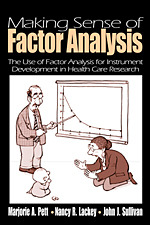
Making Sense of Factor Analysis
The Use of Factor Analysis for Instrument Development in Health Care Research
- Marjorie A. Pett - University of Utah School of Medicine and School of Nursing
- Nancy R. Lackey - University of Memphis, USA
- John J. Sullivan
Making Sense of Factor Analysis: The Use of Factor Analysis for Instrument Development in Health Care Research presents a straightforward explanation of the complex statistical procedures involved in factor analysis. Authors Marjorie A Pett, Nancy M Lackey, and John J Sullivan provide a step-by-step approach to analyzing data using statistical computer packages like SPSS and SAS. Emphasizing the interrelationship between factor analysis and test construction, the authors examine numerous practical and theoretical decisions that must be made to efficiently run and accurately interpret the outcomes of these sophisticated computer programs.
Making Sense of Factor Analysis: The Use of Factor Analysis for Instrument Development in Health Care Research offers a practical method for developing tests, validating instruments and reporting outcomes through the use of factor analysis. To facilitate learning, the authors provide concrete testing examples, three appendices of additional information, and a glossary of key terms. Ideal for graduate level nursing students, this book is also an invaluable resource for health care researchers.
an excellent and very useful book for anyone embarking on factor analysis
Absolutely brilliant - descriptive, easily read and motivating. Good examples from health and particularly a good description of different rotations, why we do FA, explains the print outs. All my colleagues want to borrow it too!
Good for students doing questionnaires with a large number of participants.



